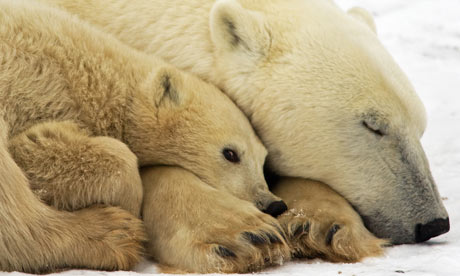US to lobby for endangered species listing for polar bear
Melting sea ice in the Arctic will kill thousands of bears in coming years, the US says, and continued commercial trade must not be allowed to make the situation worse

Polar bear products are used for furs, rugs and taxidermy. Photograph: Paul Richards/AFP
by David Adam, environmental correspondent, The Guardian, March 12, 2010
It is a familiar story in the climate change debate. The US government is at odds with the rest of the world and, despite criticism, wants other countries to change their minds and fall in line behind Uncle Sam.
This time, the tale comes with an unexpected twist. This weekend, the US will warn that the threat from climate change to the survival of the polar bear is so great that the world must grant it the highest possible protection.
At the meeting of the international body that regulates trade in animals, the US will push for a total ban on the sale and movement of polar bear products that are used for furs, rugs and taxidermy. Melting sea ice in the Arctic will kill thousands of bears in coming years, the US says, and continued commercial trade must not be allowed to make the situation worse. Other countries, including US neighbours and keen polar bear traders, Canada, disagree.
The US has put its proposal to the Convention on International Trade of Endangered Species (CITES), which meets every 2-3 years and tomorrow begins its 12-day meeting in Doha, Qatar. Governments from 175 countries will discuss dozens of such proposals, which could help determine the fate of, among others, elephants, tigers, rhinos and the world's dwindling stocks of bluefin tuna.
"2010 is a key year for biological diversity," said Achim Steiner, head of the United Nations Environment Programme, which runs CITES. "It is the year when the world was supposed to have reversed the rate of loss of our biodiversity. This has not happened. The international community must re-engage and renew its efforts to meet this goal. CITES is an important part of this response."
The US wants polar bears promoted to CITES Appendix I, which brings an automatic ban on trade. In its proposal it says: "Sea ice changes will likely negatively impact polar bears by increasing energetic demands of seeking prey. As changes in habitat become more severe and seasonal rates of change more rapid, catastrophic mortality events that have yet to be realised on a large scale are expected to occur."
It adds: "A precautionary approach, which includes polar bears in CITES Appendix I, is necessary to ensure that primarily commercial trade does not compound the threats posed to the species by loss of habitat."
Biologists reckon there are 20,000 to 25,000 polar bears in the Arctic, spread across 19 geographical sub-populations. Last year the polar bear specialist group of the International Union for Conservation of Nature said that numbers in eight of these groups were declining, three are stable and one, a group of under 300 animals around Canada's M'Clintock Channel, is increasing. The state of the other seven groups is unclear.
The US plan is backed by Egypt and Rwanda, but other nations, including Europe, are expected to vote against. Canada, which exports skins and products from about 300 polar bears legally shot each year, says the trade is insignificant compared to the threat of global warming.
There are also doubts about whether the polar bear meets the required criteria for Appendix I listing. In its official response to the US proposal, the CITES secretariat recommend it is rejected. "The global population of polar bears does not appear to be small. The area of distribution of this species extends over several million square kilometres and is clearly not restricted at present," it says. "There is insufficient evidence that the species has undergone a marked decline in population size in the wild large enough."
[Readers, remember that absence of evidence is not proof of absence.]
Link: http://www.guardian.co.uk/environment/2010/mar/12/polar-bears-endangered-species-listing







No comments:
Post a Comment